
On July 19, the special exhibition "Talasa: Maritime Civilization and Greek Art" was opened to the public at Shanghai Expo. Mr. Vasileios Koniakos, Consul General of Greece in Shanghai, and Helen Moussa, Consul of the Public Diplomacy Office of the Consulate General of Greece in Shanghai Ms. Qi (Eleni Moutsaki) took readers to "travel" to the blue Aegean seaside to experience Greek art in an immersive way.
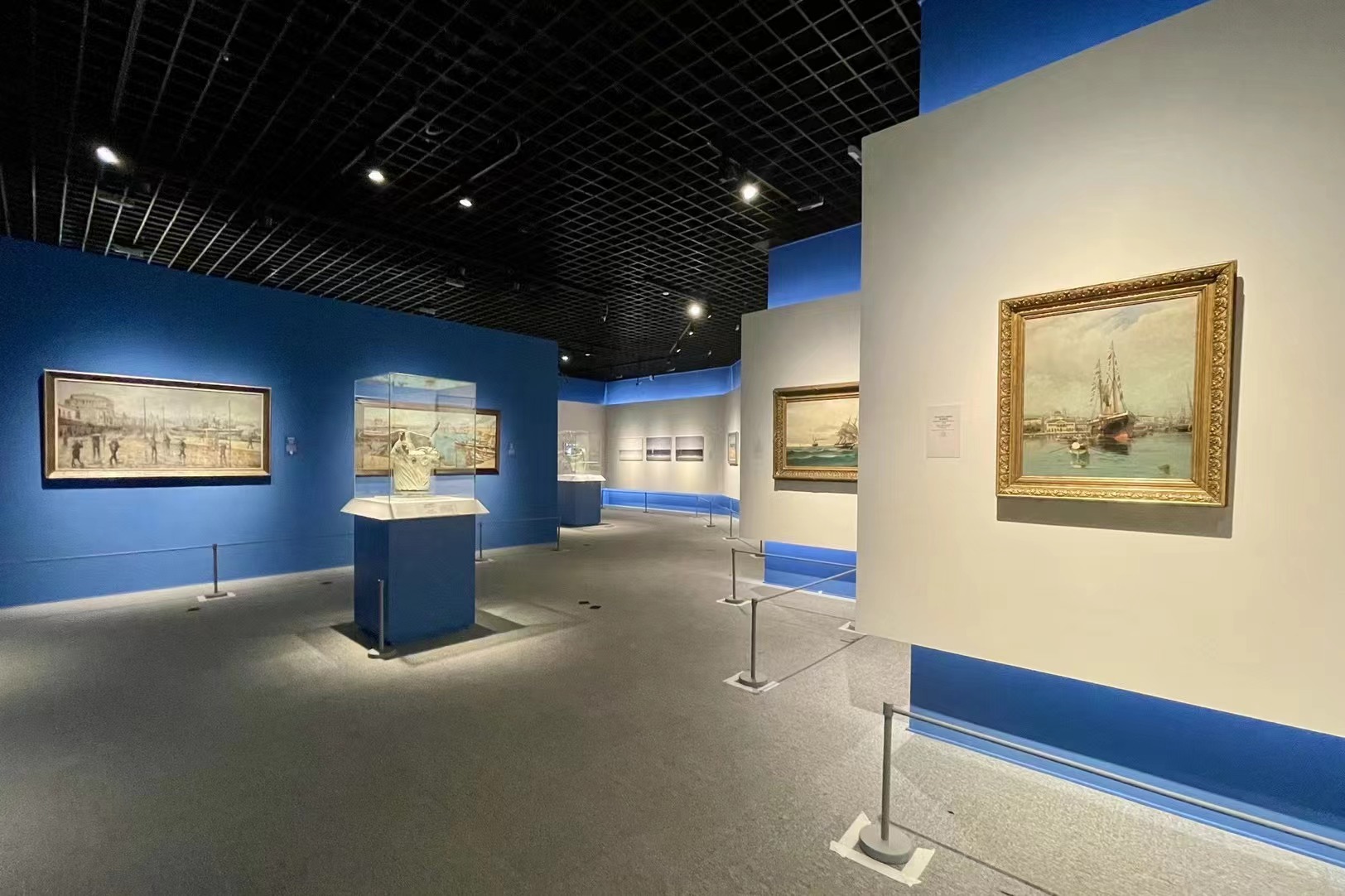
exhibition site
language and emotionSea, journey, flow, life... These are the key words of the "Talasa" exhibition in the eyes of Greek consuls.
Vision, language and emotion are blended here. What kind of associations do these words make to you? What emotions will it stir up?
Q: What does "Talasa" in the exhibition title mean? What does it mean in Greek civilization?
Koniga: "Thalassa" means sea in Greek. In my opinion, it is probably the most beautiful Greek word. What's even more amazing is that centuries have passed, and the pronunciation of this ancient word has not changed much for thousands of years. Now the term is also gaining more international dissemination and recognition. Especially in some western countries, such as France, Thalassa means the ocean. The term is gradually becoming internationalized.
Q: If you were asked to describe this exhibition with three key words, what would you use?
Koniego: The first word, I think it's Journey. When you see these seas and seascapes, ships and ports, they are easy to arouse your curiosity, and make you sincerely have a desire to explore, to see what is on the other side of the sea. So, the first word that comes to my mind about this exhibition is Journey.
The second word is Motion. Because the water here is always alive and flowing. As the ancient Greek philosopher Heraclitus said, "A man cannot step into the same river twice."
The third word is Life. Yes, the never-ending voyage is like never-ending life. You are always on the go, constantly discovering new things.
Q: In this exhibition, which piece of work resonates with you the most?
Koniego : This exhibition is very rich, it can be said to be all-encompassing. From historical relics to modern and contemporary works of art, there are traditional easel paintings, photography, video art, and a work created using artificial intelligence. In fact, I am still exploring in the exhibition myself, but there is one work that strikes me, and it is Yannis Maniatakos's "Silent Under the Sea". What is special about this piece is also the performance of light. It's supposed to show what the seabed looks like, so you can see from lighter light to deeper blues. Because I am a diving enthusiast, this picture is very kind to me who is a frequent diver. The deep sea, and this deep blue, are really suitable for summer viewing.
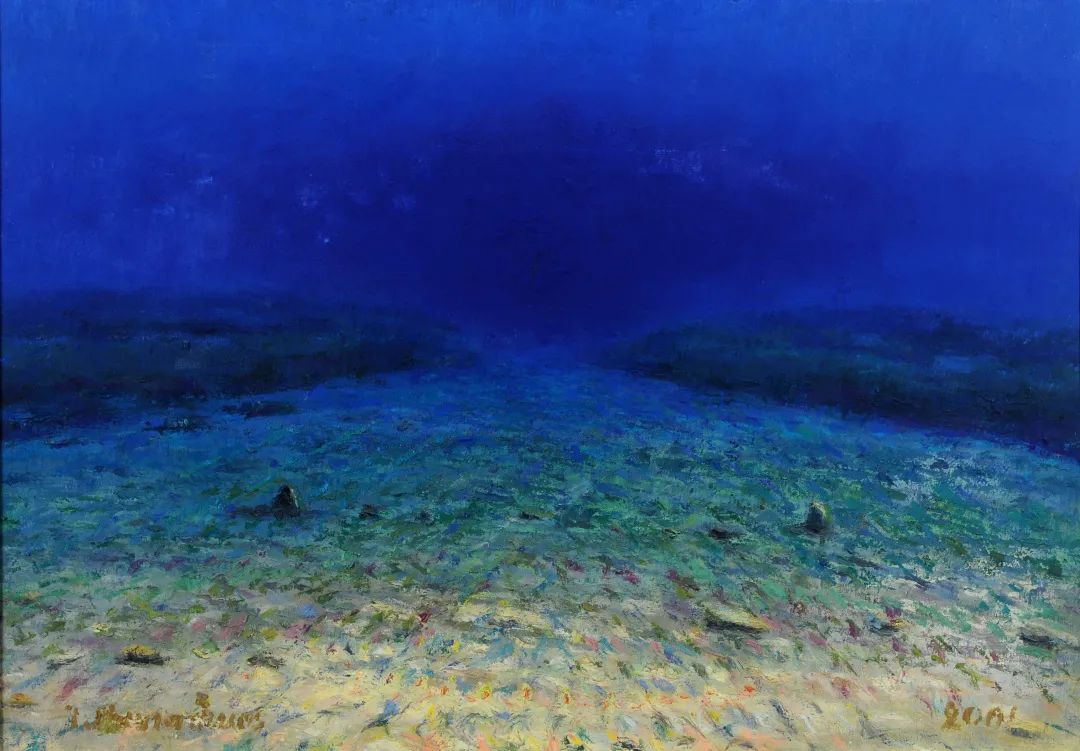
Giannis Maniatakos, "Silent Seabed", 2001, oil on canvas (underwater painting), 67x95 cm, private collection
Helen Musage: My favorite work in this exhibition is the series by Konstantinos Volanakis. He is a typical Greek painter known for his landscape paintings, and his works contain a lot of marine elements. As a Greek, when we think of ourselves, we immediately think of the ocean. The sea "Thalassa" is also an important part of Greek life, culture and spirit. This is also an important point we want to express to the Chinese audience in this exhibition.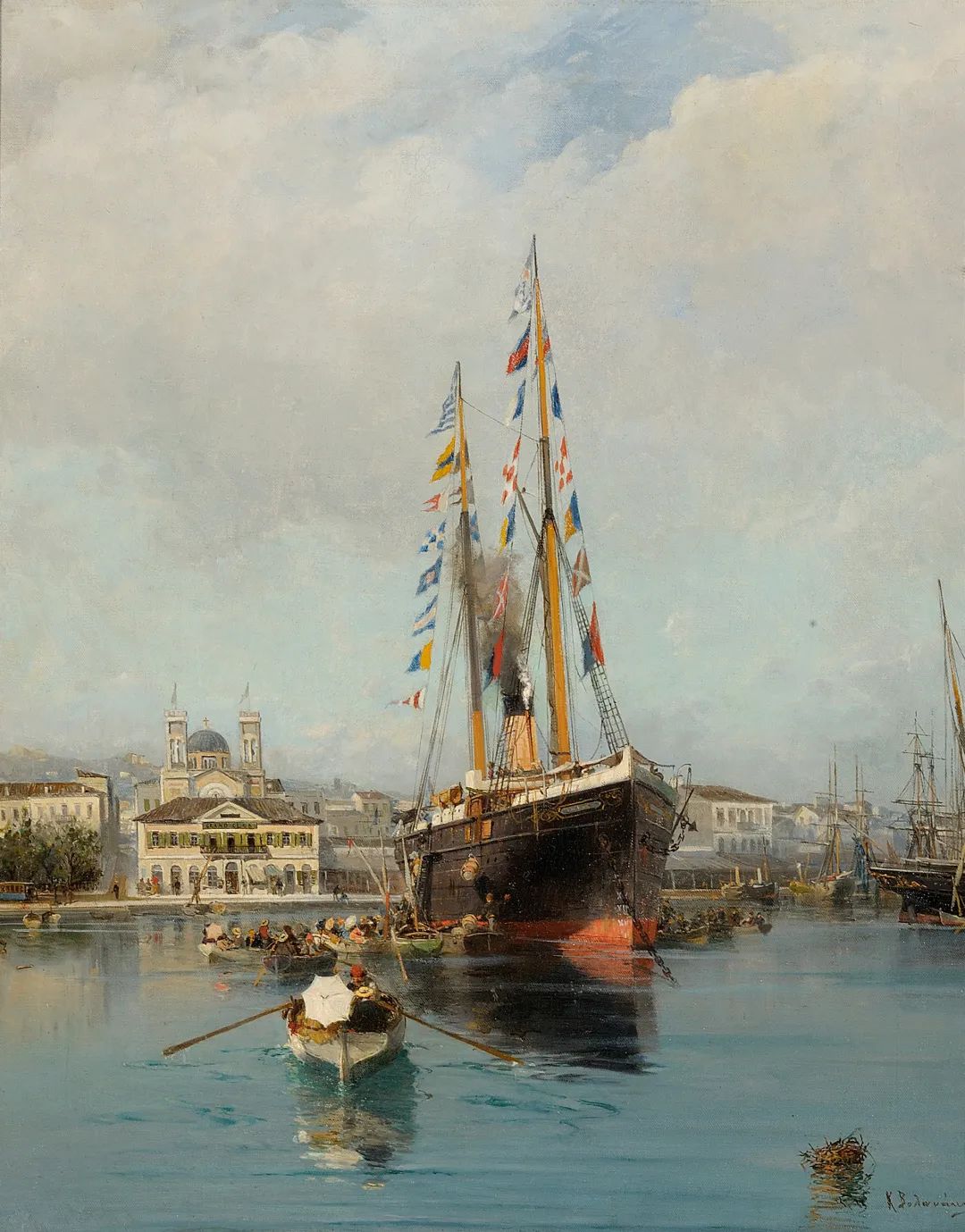
Konstantinos Volanakis (1837-1907), "Sail from Piraeus to Tinos", oil on canvas
64x52 cm, private collection
What does Greece look like outside of ancient Greece? An artistic look back at the traditions and knowledge of Greece from ancient times to the twentieth century.
Coming from time, running through the past and present of this marine civilization.
Q: This exhibition presents the history and culture of Greece in a visual language, and is mainly divided into two parts: ancient and modern and contemporary. In what ways do you think ancient Greek art differs from modern and contemporary Greek art, and in what ways do they continue?
Helen Musage: In my opinion, every work in this exhibition shows the mutual influence of Greek culture and history, because every historical stage will leave important artistic products, and the inspiration of artistic creation also comes from history . In this exhibition, the audience will see the story behind the art, from ancient Greece to modern and contemporary Greece.
Chinese audiences may be familiar with ancient Greece and ancient Greek mythology, but little about modern and contemporary Greek art. First of all, I must say that ancient Greece is often the source of inspiration for modern Greek art. For example, the work "Siren-Odysseus" in this exhibition, the artist's inspiration came from a pottery bottle in ancient Greece. A retelling of the mythology, this vase is now in the British Museum.
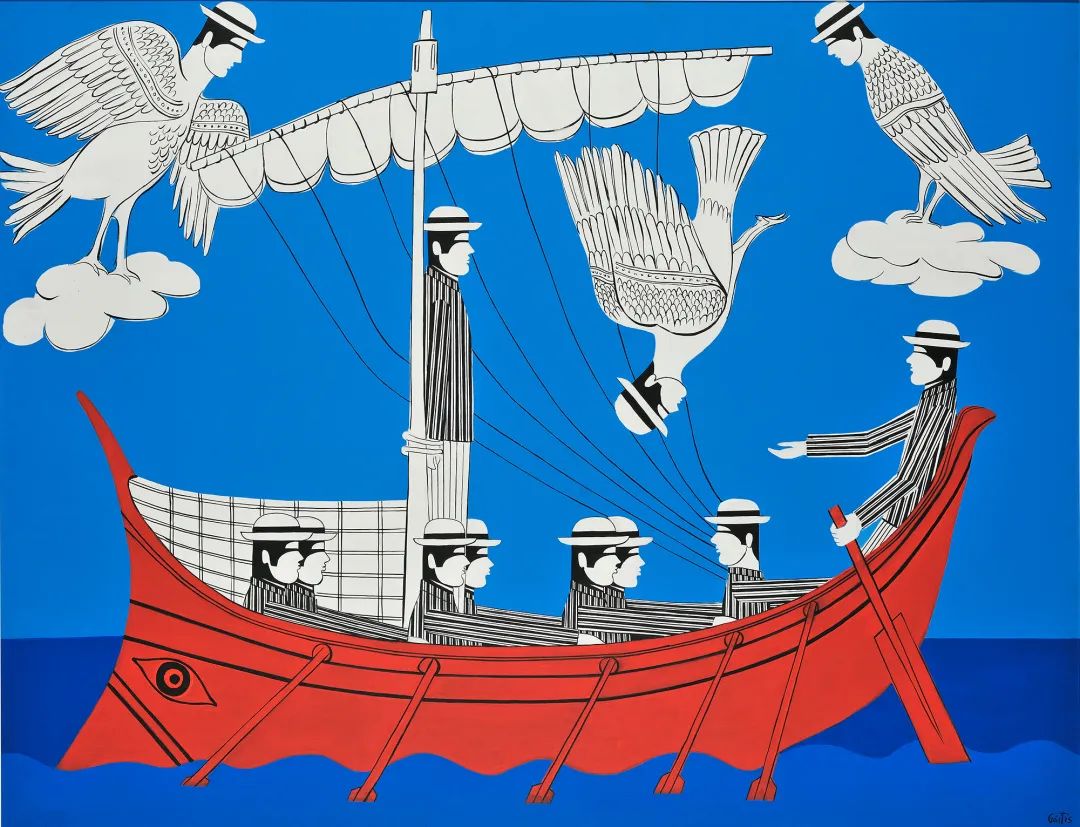
Giannis Gettis, Siren-Odysseus, 1980, oil on canvas, 150x195.5 cm, National Gallery - Collection of Alexandros Sussos Museum

An ancient Greek pottery vase inspired by the artist, now in the British Museum. @The Trustees of the British Museum
Another example is the artist Konstantinos Volanakis, whose works are also on display in this exhibition. Many of his series of works are influenced and inspired by the Greek War of Independence. It is also very important that we have the opportunity to present to the Chinese audience not only traditional oil paintings, but also works produced using various techniques and media in this exhibition.
Konstantinos Volanakis (1885-1896), Seascape, oil on canvas, 65x113 cm, Bank of Greece Art Collection
Q: Due to the epidemic, it is a pity that the originally planned twelve ancient Greek cultural relics could not come to Shanghai. But we still have five exhibits of ancient Greek artifacts presented in holographic projections. Why were they chosen then?Helen Musage: There are five ancient Greek artifacts in this exhibition. Although they are presented in the form of holographic projections, these five exhibits are definitely the most beautiful. My personal favorite is "The Youth Riding a Dolphin". In Greek mythology, there are countless stories about people and dolphins. For example, the hero Odysseus in ancient Greek mythology carved a dolphin on his shield, because the dolphin saved his son from danger in the sea. This reflects the coexistence between man and nature, and it is also one of the viewpoints that this exhibition wants to express.

A young man riding a dolphin, 475-450 BC, bronze, 7.5 cm high, 10.5 cm long, excavated from the Acropolis, in the collection of the Acropolis Museum
from the oceanThe Greek mainland and its many archipelagos are bred in the ocean. Here, there are quiet towns and busy ports. Unfamiliar yet familiar.
Starting from the ocean, you can reach another ancient continent... The ocean civilization and the continental civilization have a dialogue here.
Q: In this exhibition, there are many works depicting Greek landscapes, including oceans, islands, and ports. Chinese audiences may not be familiar with these place names or coordinates. Which places or landscapes do you most want to introduce to Chinese audiences?
Helen Musage: Konstantinos Maleas' oil painting "Monemvasia" is one of my favorites in this exhibition. The work depicts a medieval city of Monemvasia on a small peninsula on the east coast of the Peloponnese. This is very typical Greek architecture, as can be seen from the traditional architectural elements, the materials used, the design of the house, and even the stone oven on the left side of the picture. The houses nearby and the blue ocean not far away echo each other. Rocks, oceans, sunlight, etc. all show typical Greek scenery, because the status of the sea is irreplaceable in the hearts of Greeks.
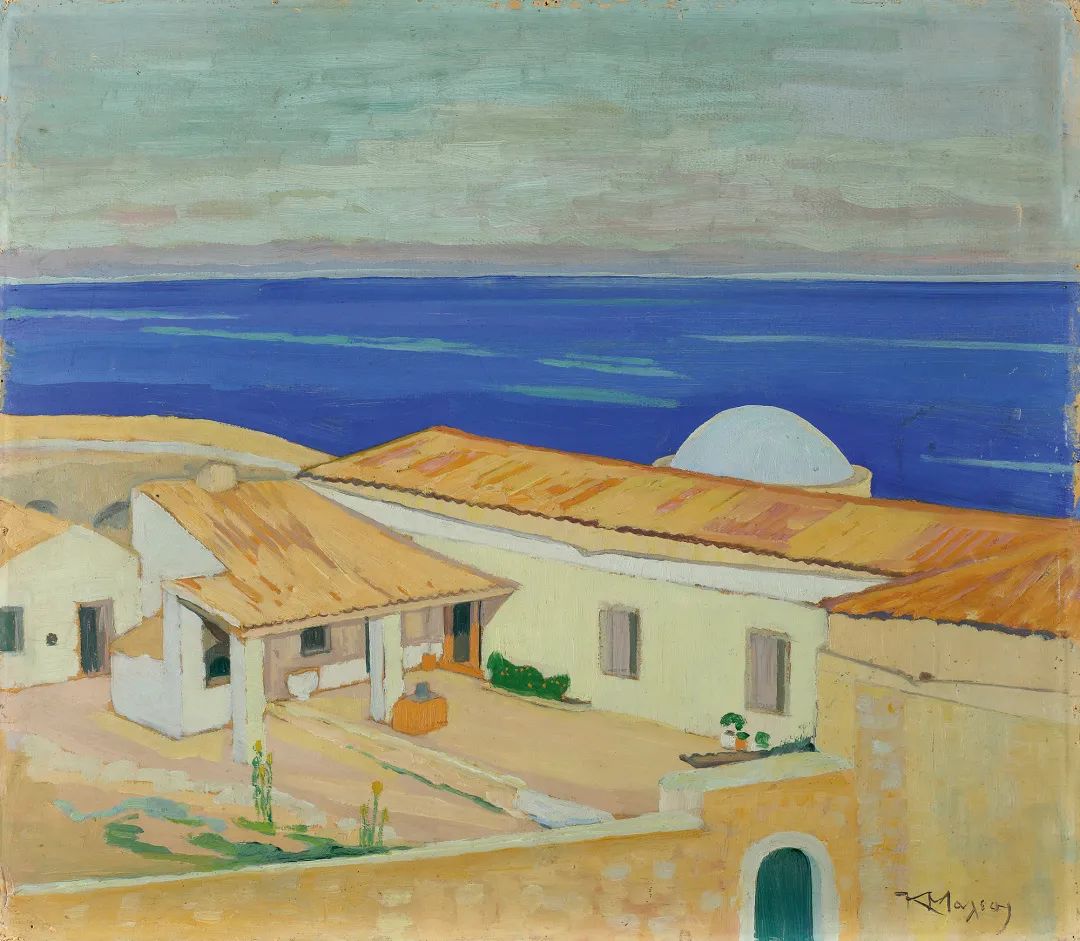
Konstantinos Malias, "Monemvasia (House of Monemvasia)", oil on cardboard, 50x57.5 cm, Bank of Greece Art Collection
There are also two exhibits on ports, they depict the largest port in Greece, the port of Piraeus, which is also one of the largest ports in the Mediterranean. The two works are only 4 years apart, but the rapid development of the port creates a strong contrast through buildings, roads, steam ships, trams, etc., showing the speed of the development of the port of Piraeus.
Michael Axelos, Piraeus, 1934, oil on canvas, Bank of Greece Art Collection

Stratis Arciottis, "In the Port of Piraeus", 1938, oil on canvas, collection of the Municipal Art Museum of Piraeus
Q: Greece is a maritime civilization, while China is a continental civilization. How do you see the differences and connections between the two civilizations?Koniego: This is certainly not an easy question to answer. In fact, we have carefully selected the exhibits of this exhibition in order to fit the Chinese audience and let them see the commonality in it. For example, there are ancient bronzes (virtually presented in holographic projections) in this exhibition. Ancient China also had a very great bronze culture, but you can still spot some differences. For example, the Greek bronzes on display this time, a bronze statue of Poseidon, and another statue of a young man riding a dolphin, have many themes of gods or people. I think this is different from China, where Chinese bronze culture pays more attention to ritual utensils and thinks more about form. So at least in my opinion, this is the difference between the civilizations of the two countries.
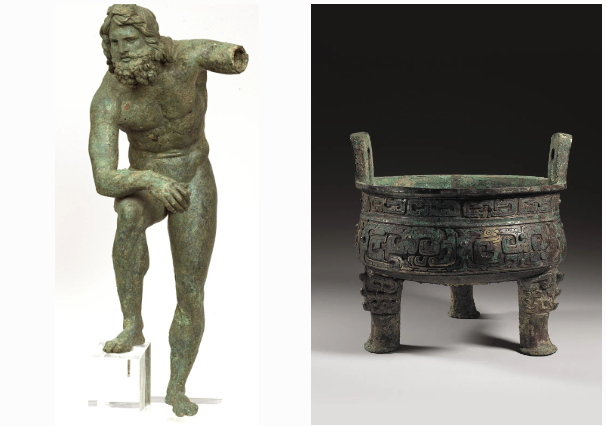
Left: Statue of Poseidon, 2nd century AD, bronze, unearthed in the Amberokipi area of Athens, in the collection of the National Archaeological Museum of Athens;
Right: Qin Gong Ding, Early Spring and Autumn Period (770 BC - the first half of the 7th century BC), bronze, in the collection of Shanghai Museum
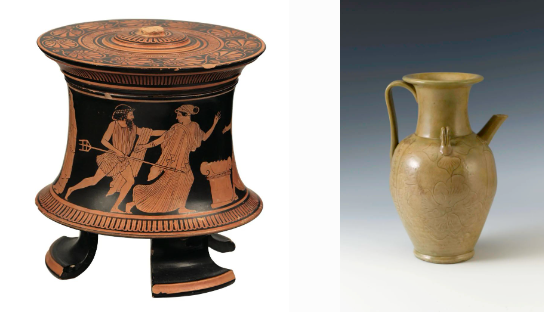
Left: Attica red painted box with lid, 470-460 BC, clay, 12.5 cm high, 8.8 cm diameter, 13.5 cm lid diameter, in the collection of the National Archaeological Museum of Athens;
Right: Yue kiln celadon glaze "Dazhong first year" inscribed flower holding pot, Tang Dynasty (618-907), height 27 cm, diameter 10.3 cm, abdominal diameter 16.2 cm, bottom diameter 9.9 cm, collected by Shanghai Museum
In the way of exhibition, we can feel and understand the Greek spirit and culture so closely.
I hope to bring coolness and comfort to everyone in the sweltering heat, as well as the joy of sailing freely, not being afraid of difficulties, and exploring new things.
Q: In this exhibition, which artist would you most like to introduce to the Chinese audience?
Koniego: We actually happened to be right in front of my favorite piece. Although the size is small, it is very important in my opinion. This is a work by the Greek Impressionist painter Michalis Economou. Economus was known in Greece for his ability to harness light. In this painting, we can also see the sparkling waves on the water. In my opinion this work is a very beautiful masterpiece of the artist. The color is bright, the lines are very simple, and there are some seemingly random reds in the ocean. Look at it from a little distance and you will understand the scene the artist is depicting. This work is actually very typical of how the Greeks understood and perceived art - it must be concise, or, in other words, less is more. Again, we should note that this is a work done in the early 20th century, when it was quite avant-garde. The artist actually had a hard life. He suffered from mental illness and had to be sent to a shelter. But maybe geniuses are more difficult. That's right, this is my favorite piece of work in this exhibition.
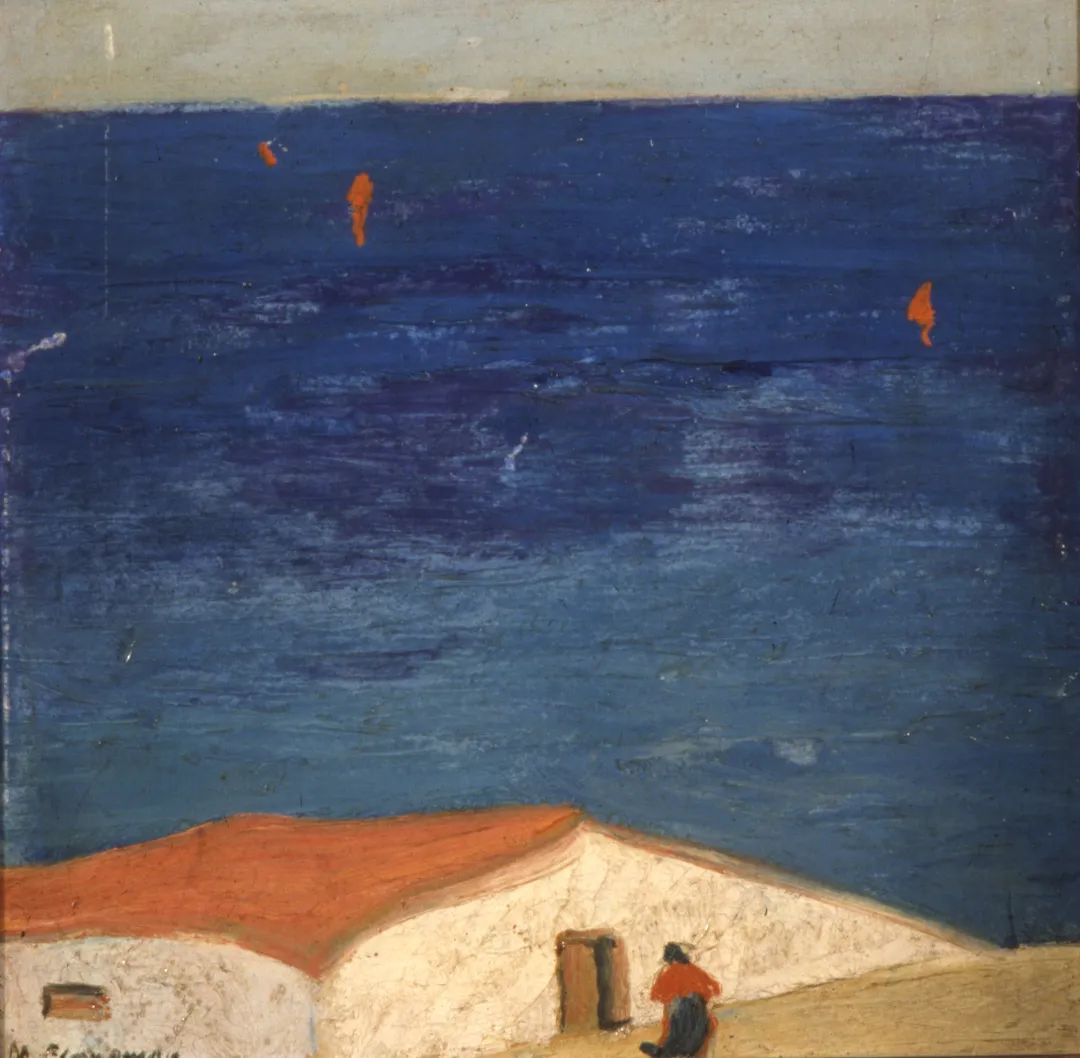
Micalis Economou (1884-1933), "The House by the Sea", oil on canvas, 30x30 cm, Municipal Art Gallery of Larissa - GI Cassiglas Museum Collection
Q: Walking through the exhibition hall, when viewing this exhibition, it is easy to think of Greek-related texts and other art forms (epic, drama, film, music, etc.), what do you think of?Konig : The first thing that comes to my mind is the Odyssey from Homer. In this exhibition, there is an oil painting by Giannis Gettis, Siren-Odysseus, which is very reminiscent of a chapter in the Odyssey. This chapter tells the story: Odysseus (Ulysses) was tied to the mast so that he could hear the siren's beautiful song without putting himself in danger of becoming a siren's belly . His crew plugged their ears so as not to be seduced by the singing.
As for the movie, I am reminded of "Blue Sea and Blue Sky". It's a French film, but filmed on the Greek island of Amorgos. This is a story about freediving, the constant challenge.
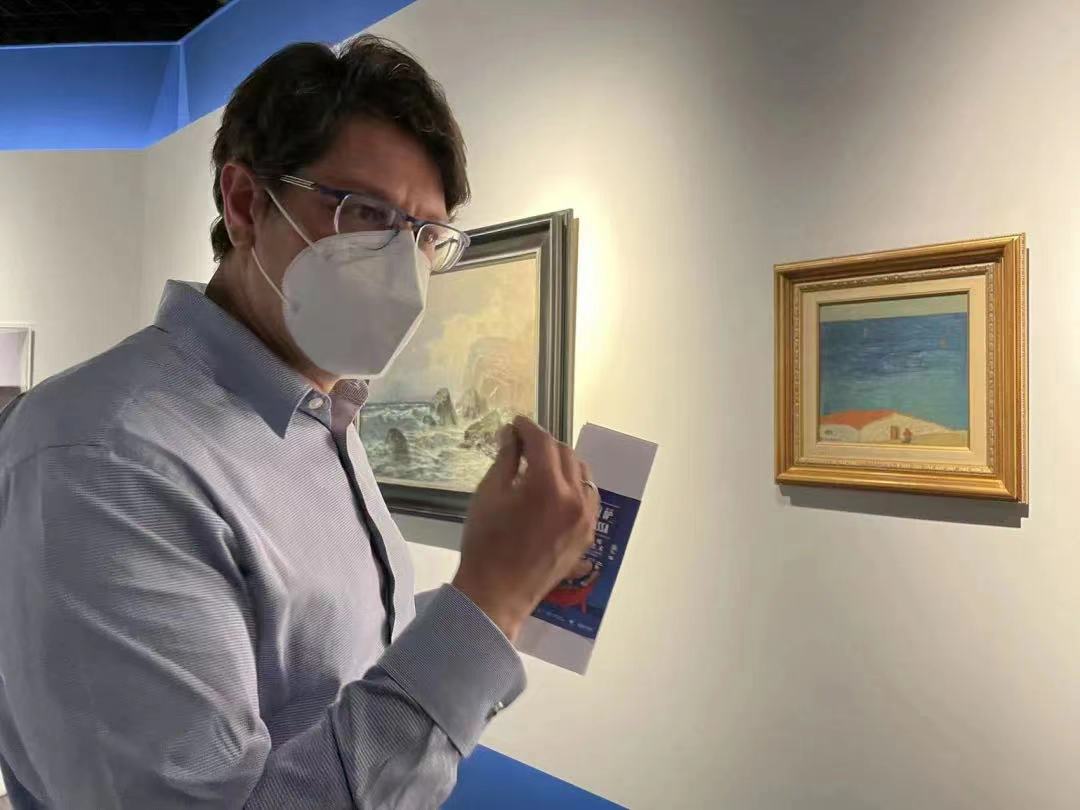
Konig in the showroom
Q: Is there anything else you would like to say to the Chinese audience about this exhibition?Helen Musage: I think this exhibition is very suitable for student groups to visit. "Thalassa" Greek Ocean is a very beautiful theme. The art in the exhibition also brings us into encounters with great literature such as Homer's epics. Art and literature form an intertextuality, which is a great learning opportunity. Parents are welcome to bring their children to the exhibition hall, not only to visit, but to treat this exhibition as a pleasant journey.
Koniego: In order to make this exhibition possible, we made a lot of efforts and overcame many difficulties. But I think this exhibition can be seen as a small victory. This is a further step in the relationship between Greece and China. At the same time, it will also be a triumph for the Shanghai Museum and the city of Shanghai. We have overcome the epidemic and completed this exhibition. From the exhibition, we have the opportunity to experience the freedom of navigation. The feeling, the feeling of exploring new things. In short, you are very welcome to visit and explore the exhibition "Talasa: Maritime Civilization and Greek Art" at the Shanghai Museum.
Note: This article is reproduced from the WeChat account of the Shanghai Museum. The Consul General of Greece in Shanghai will take you to watch "The Sea""; the exhibition will last until October 9